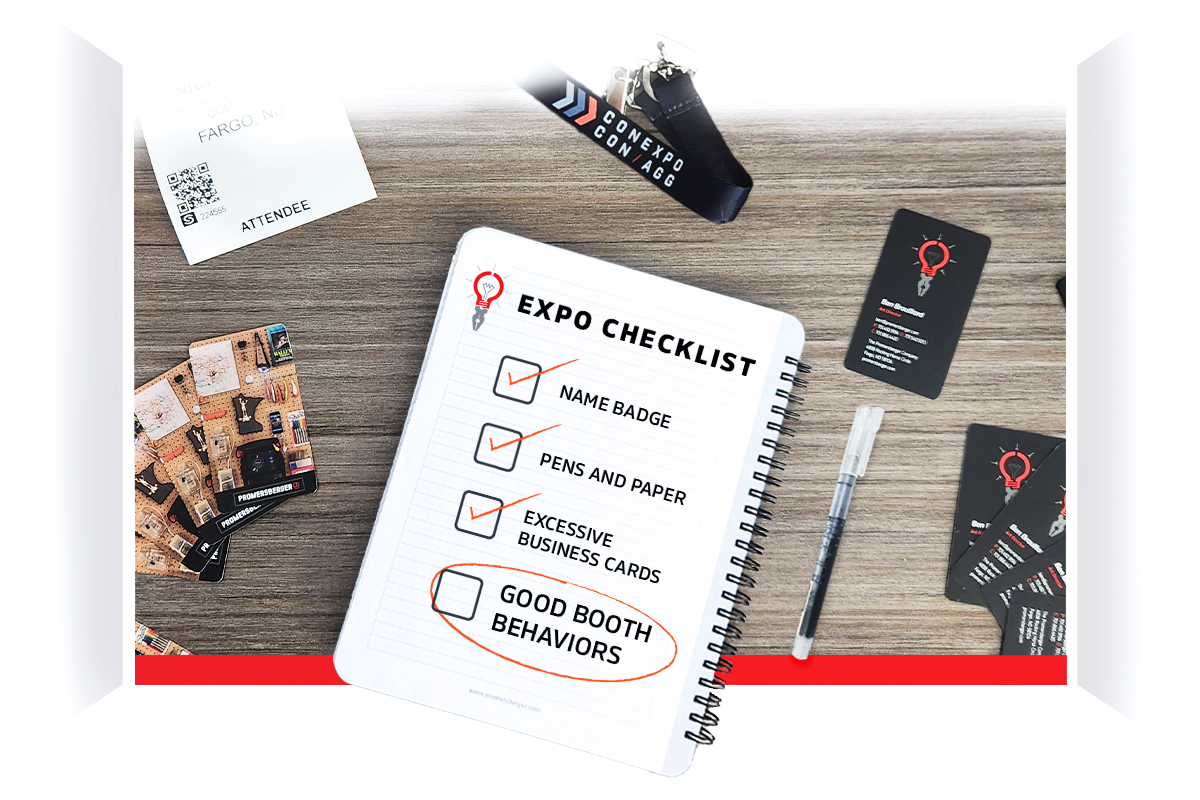The Pegboard
Bad
Booth Behaviors
Part 2 of 2 — By Jon Thorp

I’ve been attending trade shows for nearly 30 years and observed my fair share of bad booth behaviors. Having just visited a few trade shows again this fall, what better time to follow up on our previous trade show booth article? Here are my additional observations that can help exhibitors make the most logical use of their booth space and stay on their best booth behavior.
The Overload
Regardless of the size booth you’ve booked, trade shows are expensive. Loading up every square inch of that booth with equipment may feel like the best way to maximize the investment, but it’s actually counterproductive.
Open booths are simply more welcoming. With overloaded booths, you usually see visitors hovering around the perimeter. Whether they are overwhelmed by the presentation or are worried they’ll be trapped by a salesperson if they dare venture into the labyrinth, the result is fewer visitors and defeating the whole purpose of being at the show in the first place.
A good rule of thumb is to only fill up 50% of your booth footprint with exhibit components (equipment, literature stands, tables, etc.). That might seem like a waste, but the important upside is that it allows staff members to have ample space to interact with visitors. Some display companies suggest up to 50 square feet per staff member. That may be a bit pie-in-the-sky, but it’s good to understand that if you’ve reserved 10 square feet per person, that usually means they will be an arm’s length from the next person.
The Pointless Promotion
How does a putting green or basketball hoop relate to a skid steer? It doesn’t. Yet that doesn’t prevent exhibitors from putting random games or other promotions into their booths in an effort to maximize booth visits.
Yes, you want people coming into your booth, but if most are trick-or-treaters just looking for a freebie, very little is gained. What you want more than sheer numbers is to get the right people into your booth.
This can be achieved by making the promotion directly relevant to your product offering or doing something that requires the visitor to engage with the product. That way a valuable message is conveyed. In one instance, we worked with a client promoting the efficiency of their drill and how it could make the perfect hole every time. Just like that, a hole-in-one putting green promotion made sense. And to help filter traffic, we made the big prizes only available to those invited to the booth.
The worst in-booth promotions do more harm than good. At a recent show I attended, an exhibitor had a basketball hoop in the booth. I did my best to figure out why, but the only conclusion I came to is they had the space for it. Nearly every time I passed the booth, two random yahoos were shooting hoops, and making a lot of noise doing it. The last time I walked by, the employees manning the booth had completely turned their back on the airball-fest in progress, thoroughly annoyed by the constant distraction.
The Mad Scanner
In line with the Pointless Promotion are those booths aiming to scan as many badges as possible. In the old days – before scanners – many exhibitors hired what were termed “booth babes” as a way to attract men into the booth to provide their contact info. Fortunately, that archaic approach has mostly left the industry, but for some reason this interest in maximum scans remains.
Again, the idea is to get the right people into the booth, not just anyone. For those still giving out free items in exchange for scans, I imagine this is highly annoying to the sales team if they are handed these “leads.” Salespeople have limited time, and spending any of it calling someone who just went to the booth to get a hat must be deflating.
The key is to add that extra step of qualifying the leads before handing them to the sales team. With the scanning software today, this is actually quite simple, and it seems most exhibitors are taking the extra time to enter the relevant information. But every once in a while, I still get direct calls or e-mails from a salesperson asking about my interest in the product after visiting their booth. I always feel bad letting them know that they wasted some precious time calling on a marketing guy.
The Buffet
From the time we are kids, it’s ingrained in us not to interrupt people when they’re having dinner. And when you walk into a booth and realize everyone is eating, the urge to apologize and flee is second nature.
Admittedly, I don’t see this one as much as I used to. The combination of multiple food options now available in the concourses and most exhibitors splitting up lunch schedules and sending people off the show floor to eat has made it a rarity. But on occasion, you see that full buffet going on and you’ll also usually notice there’s no one else in the booth. Eating is a clear message to everyone to come back later, whether you intend it that way or not.
For that matter, pretty much any activity that booth staff are engaged in – with the exception of visiting with other customers – can come off as unwelcoming. Whether it’s eating, intensely checking emails, or having in-depth conversations with your own co-workers, it’s best to keep those behaviors in a walled-off meeting space … or out of the booth altogether.
Do you have your own trade show tips?
I’d love to hear about your personal trade show experiences. Which challenges are hardest to overcome, even when you’re fully aware they exist?
